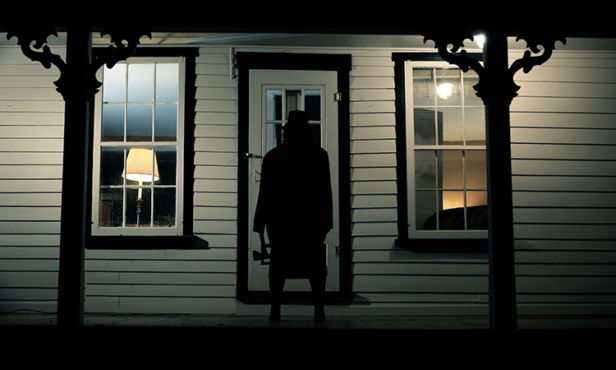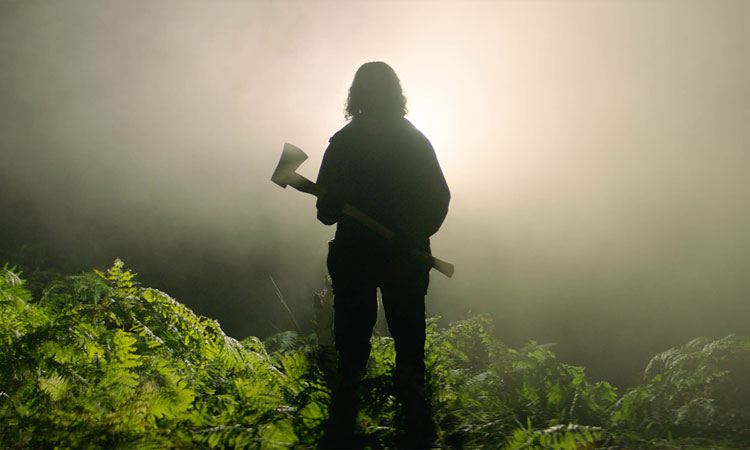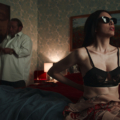Where The Devil Roams begins as it ends: on a stage. Shot in flickery monochrome to mimic film from the period, a tattooed, tuxedoed man with no legs drags himself across the platform, and reads aloud from a book before a suited, seated, enraptured audience.
His enchanting poem tells of the angel Abaddon being cast from Heaven, falling in love with a mortal woman, and keeping alive her heart (“with the Devil’s needle lodged inside”) after the rest of her body dies and decays – a heart that becomes a powerful talisman “for those who like to cut and sew”. The sequence is programmatic, setting the stage for a film (otherwise shot mostly in colour) that is also full of sideshow freaks, severed parts, and slips from grace that are also, depending on how you look at them, miraculous transcendences.
In the broken America of the Depression era, we meet a broken family. Maggie (Toby Poser), who as a very young girl joined her sister in the murder of their parents, has now grown up to be a serial killer, always motivated in her bloody assaults by a sense of righteous injustice, but not always smart enough to make good judgment calls on her own criteria.
Trained surgeon Seven (John Adams), who married Maggie after returning from the Great War shell-shocked by what he saw – and did – in the European Theatre of Operations, is now paralysed by the very sight of blood. Their young adult daughter Eve (Zelda Adams) is mute, but seeks other outlets for expression, including a (paradoxical) talent for singing, a love of photography (mostly morbid images of the corpses her mother leaves behind), and an obsession with both dismembering and fixing dolls with scissors, needle and thread. “You may have got your dad’s hands for sewing, but you got mine for stickin’“, Maggie will comment, recognising that Eve is, like all children, a composite of her parents, stitching together their best and worst qualities. Eve’s very name, whose Biblical resonance is explicitly noted, places her in a primordial garden of good and evil. She could go either way.
All three members of this family are damaged, but they work well together, covering for one another’s flaws and filling the loneliness of the road with a deep love for each other. Having lost their home, they are also themselves stage artists, travelling the byroads of the Catskills’ fading carnival circuit for a little camaraderie and even less money.
Their act, with at its centre a singing Eve dressed as an angel while Maggie and Seven dance robotically – like puppets – on either side of her, is hardly a showstopper, although Maggie recognises Eve’s genuine abilities and knows that with a bit more effort and practice they could improve, maybe even make it to the coveted Buffalo Horror Show. Or perhaps they could just use a gimmick. After all, their colleague Mr Tipps (Sam Rodd) knows how to pull in a crowd with a grotesque performance that incorporates on-stage self-mutilation – and his wounds, however grievous, always seem magically to have healed the following day.
Eve knows his secret, too – and when one day her own family is torn apart like Tipps’ body, she will desperately steal from him the heart of Abaddon, only failing to complete its magic because of her inability to utter or communicate the associated incantation. Yet somehow, in the end, a way will be found to stitch this family back together again.
John Adams and Toby Poser, along with their daughters Zelda and Lulu Adams, have always made family films, not just in the sense that they are an actual family of closely collaborative filmmakers, but also because almost all of their films – and certainly all of their recent horror titles, including The Deeper You Dig (2019), Hellbender (2021) and now this – focus on dysfunctional families doing their best to stay together. These later horror films, first materialising when the Adams daughters became old enough to participate in them, are not – indeed cannot be – straightforwardly autobiographical, but it is hard not to discern in them the Adams family staging its own interrelationships and anxieties.
After all, like the itinerant clan in Where The Devil Roams, the Adams family is itself often on the road, often engaged in artistic endeavours, often on a circuit (albeit of film festivals rather than of old-school carnivals), is a musical band (whose gothic rock features in the film) and has gradually shifted its work towards the macabre and the carnivalesque, even as they have travelled a path from the outer margins of independence towards more mainstream acceptance within the genre community (here figured as an ever-growing audience entranced by the grand guignol that has now become an integral part of Maggie, Seven and Eve’s act).
Every family worries about its eventual, inevitable dissolution, and fantasises about a miracle that might prevent it. Much as Lulu Adams was the first to fly the coop and head off to university away from the Adamses, here she plays a character who drives a wedge between an otherwise close-knit family – and Where The Devil Roams imagines a daughter (or, at its beginning, two daughters) left to face their family slowly falling apart, and to salvage something from what remains.
Yet it will eventually reach its highly theatricalised solution to this problem via the Frankenstein myth, Juan Piquer Simón’s Pieces (1982), Lucky McKee’s May (2002), Tyler MacIntyre’s Patchwork (2015) and even Robert Hiltzik’s Sleepaway Camp (1983), with a final, sublimely transgressive image that graphically illustrates how we are all just a monstrous amalgam of our inherited influences, for better or worse. In this case, it is very much for the better, as the Adams family members once again exhibit themselves as matchlessly mesmerising outsider artists who have finally made it to where they belong, on centre stage.
This is a tale of the American Dream’s nightmarish flipside, turning downtrodden characters’ hard knocks into hell- (and gender-)bending hard rock, and letting Eve bite the apple, find her voice and give the Devil her best tunes. The freakish entertainment that ensues is pure, albeit avant la lettre, metal.
Where The Devil Roams has its world première at Fantasia 2023. Find more reviews at SciFiNow.




